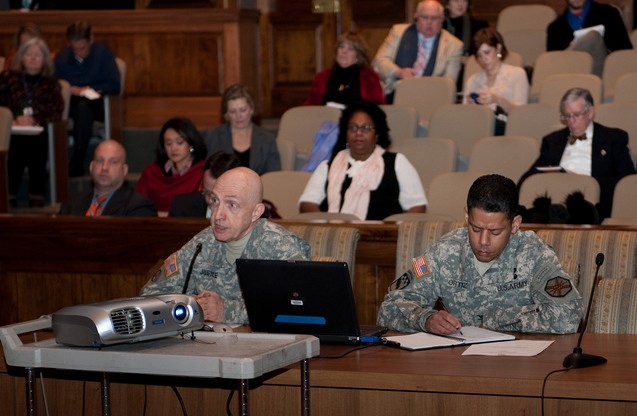
ANNAPOLIS, Md. (Jan. 18, 2011) -- The Base Realignment and Closure legislation of 2005 is on schedule, said Maj. Gen. Nick Justice, senior installation commander for Aberdeen Proving Ground, Md., in remarks here, Jan. 18, to members of the Maryland General Assembly.
"It's the second- and third-order of effects of the relocation of people and facilities that are very important for the committee to be aware of," Justice said to the Joint Committee on Base Realignment and Closure, or BRAC.
Justice focused on four main aspects: building, renovation, demolition and sustainability.
"The $1billion effort happening in Aberdeen is being complemented by military construction accounts that are not related directly to BRAC," Justice said of the building projects at Aberdeen Proving Ground.
He cited the construction of a new headquarters for the 20th Support Command (Chemical, Biological, Radiological, Nuclear and High-Yield Explosives); new facilities for the Maryland Army National Guard's Combat Aviation Brigade; the relocation of the Army Test and Evaluation Command; and new facilities for the Public Health Command as examples of expansion at Aberdeen Proving Ground not related to BRAC.
"The Army has done a great job in aligning its own resources, in addition to the BRAC, to complement the efforts of the base relocation," Justice said.
Justice stressed the importance of renovating older facilities at Aberdeen Proving Ground. Although funding for BRAC covers the 11 new organizations coming to Aberdeen Proving Ground, there are more than 70 organizations located there.
"We're vacating a lot of the World War I- and World War II-era facilities. We're upgrading some of our utility infrastructure, and we're looking to upgrade many of the other administrative facilities," he said.
Aberdeen Proving Ground is conducting 11 laboratory revitalization projects with 86 vacated facilities for BRAC under revitalization for reuse. The U.S. Army Research, Development and Engineering Command headquarters staff is in the process of relocating to the historic "Stones" buildings, which requires additional renovation.
The Army health and dental clinics are also among the numerous revitalization projects under way.
"Quality of life is important. That is one of the reasons why people stay in the military. I think that's also true of our civilian workforce," Justice said.
Justice is most concerned about demolishing old buildings that are no longer of any use.
"The demolition area, frankly, is a priority. That's the place where we haven't done the best job in the past," Justice said.
Aberdeen Proving Ground has an ongoing demolition project that will span five years and includes 188 facilities. In 2010, Aberdeen Proving Ground demolished 54 buildings. There are also 775 housing units that will be demolished as part of the relocation.
"When we take those buildings down, we're able to clean up the property and set it into a state that makes us proud to have it there. Removing those facilities is something we're really going to focus on in the near future," Justice said.
Justice ended by talking about sustainability and workforce development.
"This is where, I think, the committee has so much focus, because the impact of BRAC will be a growing change over the next five to 10 years," Justice said.
Justice highlighted the education partnerships RDECOM has with higher education, particularly among engineering schools.
"RDECOM provides most of the engineering support for the Army, outside of the Corps of Engineers. We're looking at partnering with several universities," Justice said.
With subordinate organizations across the country, RDECOM reaches across the nation. Justice reassured the committee that all of these organizations support engineering and are synchronized through RDECOM headquarters at Aberdeen Proving Ground.
In addition to the partnerships with universities, Justice also expressed plans to begin partnerships with community colleges in Cecil and Harford counties.
Following his testimony, Justice took questions and comments from committee members. Donna Stifler (Harford County) asked Justice to clarify his concerns regarding the demolition efforts.
"So, from what I understand, this is something internal and you are just voicing your feelings on this situation to us'" Stifler asked.
"I'm not looking for you to do anything. What I am saying is we need to do a better job of letting people know that we need to clean up. That is just as important as building," Justice replied.
Throughout the hearing, it was clear Justice had a sense of anticipation of the changes under way at Aberdeen Proving Ground.
"I've probably got the best job in the United States Army, because I am privileged to be the installation commander at (Aberdeen Proving Ground) during this time," Justice stated.
Related Links:
BRAC to amplify peak moving season
STAND-TO!: Completing a Successful BRAC; Collaborating with Best Practices

Social Sharing